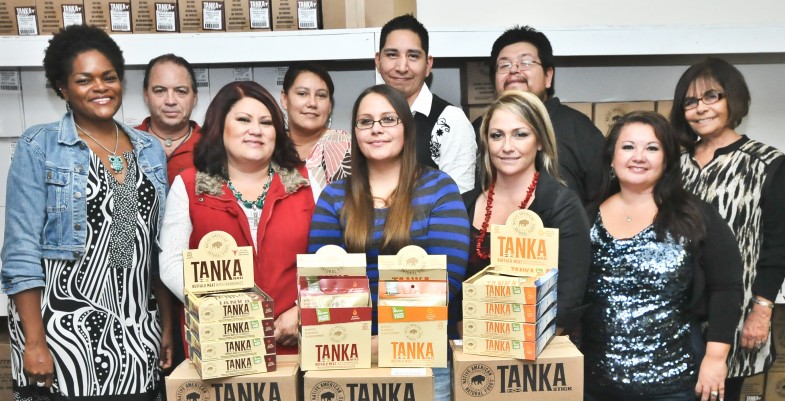The Pine Ridge Indian reservation is not the first place you’d look for good news about creating a new kind of economy that works for everyone.
This corner of South Dakota includes several of the poorest counties in America, according to census figures. Ninety-seven percent of Pine Ridge’s Lakota Indian population lives below the federal poverty line, reports the American Indian Humanitarian Foundation. The unemployment rate is well over 50 percent.
Yet these dire conditions—compounded by public health problems like diabetes and addiction—have not snuffed hope. Growing numbers of Pine Ridge residents are embracing their own traditions as a path toward healing and economic self-sufficiency.
The Thunder Valley Community Development Corporation, for instance, is moving forward on an ambitious set of projects, including a worker-owned construction company, a worker-owned IT firm and a farm to combat lack of access to nutritious food.
Even more surprising, Pine Ridge is home to a fast-growing natural foods food company, which created a healthy new product in the booming snack food industry. Native American Natural Foods was inspired by wasna (a concoction of cured buffalo meat and berries) to invent the Tanka bar—which is now for sale at Whole Foods, Costco, Amazon.com, natural food stores and other groceries across the nation. Available as a protein bar, a meat stick and in bite-size bits packaged with Lakota-style trail mix, the all-natural snack features flavors like spicy pepper, apple orange peel, jalapeno and slow-smoked original.
Tanka sales reached $5 million last year in 8000 stores, according to Forbes, and the company currently buys 25 percent of its buffalo from Native American growers, with the goal of 100 percent.
“The for-profit company—which actually is making a profit—recently gave equity to its employees,” the magazine continued, “…and they’re persevering despite growing competition from other companies selling buffalo meat with marketing campaigns that evoke a Native American theme, if not their authenticity.”
Tanka is now battling for space on grocery shelves with meat bars produced by food conglomerates—including the Epic bison bar, which was recently acquired by General Mills. Epic is an Austin-based company that originally produced the vegan Thunderbird bars, whose packaging claimed each one was “shaman blessed”. (Chocolate maker Hershey Foods also recently bought Krave, a line of snack meat products.)
That’s the dark cloud on the horizon for this Indian Country success story, says Native American Natural Foods co-founder Karlene Hunter, a Lakota who has spent her entire life on Pine Ridge. “We created the [meat bar] category but now we’re fighting with a food industry giant on something that is our centuries-old recipe.”
Hunter is certain that Tanka can compete based on the quality of their products, but is concerned that Epic’s deep pockets could outdistance them in reaching new stores and customers. “We don’t have $20 million to throw at this like a big company.”
“We started this company to regenerate our community, not just to make a profit,” she explains. “Last year we gave five percent of our company to the seven employees that have worked with us to build the company. We pay our staff good salaries for this area. We buy our wild rice from the Red Lake Reservation in Minnesota. We buy our cranberries from a company that buys from tribes in Wisconsin.”
“Tanka can change people’s perceptions of Pine Ridge and what’s possible here. We came up with a brand right here on the reservation that changed the whole meat snack industry,” says Native American Natural Food’s other co-founder Mark Tilsen, who has lived on Pine Ridge on and off since he was 16. Although not Lakota, he came to the reservation to join his father, who was a lawyer defending Native American activists involved in the Wounded Knee occupation in 1973. His children and grandchildren are all enrolled tribal members.
Hunter and Tilsen first partnered to create Lakota Express, a Pine Ridge-based communications company that created fundraising campaigns for Oglala Lakota College and other Native American causes, which they still operate. The idea for Tanka bars arose in a meeting with Lakota ranchers, who sought advice on finding more customers for their buffalo.
“We want to do something that no one has done before: create opportunity for people who live here,” Tilsen notes. “To offer people the chance to become owners and step into the position of being a manager. When you have a brand like ours, you do things that competitors don’t do.”
Three years ago, Native American Natural Foods launched the Tanka Fund to help Native Americans communities nationwide return buffalo to their land as a way to create community wealth, restore the environment and improve their diets. They introduced a new product to support the project, a turkey-buffalo-cranberry jerky bar, for which ten percent of all profits will go to the fund.
Tilsen and Hunter believe Tanka’s mission builds loyalty among their customers, who can help regenerate Native American culture by enjoying traditional Lakota food. But they worry competitors also wants to evoke those positive associations too.
“In their social media, Epic calls customers their ‘tribe.’ I even read they named their dog, ‘Lakota,’” Hunter reports. “That’s not cute, it’s patronizing—and misleading.”
While their competitors can shell out big bucks for marketing campaigns or discount prices to gain market share, Native American Natural Foods has some distinct advantages too.
They’ve been supported by philanthropic groups like the Northwest Area Foundation and non-profit organizations like the Democracy Collaborative, which fosters worker cooperatives and other forms of community wealth building across the country through initiatives like its Learning/Action Lab, which supports a cohort of four Native American communities.
And then there are the growing numbers of people who want to know all about the food they eat and products they buy. “A lot of younger customers, especially, want to drill down into where the food comes from,” says Tilsen. “They are searching for the truth, not just a story cooked up by the marketing department. A lot of our customers have those values.”







